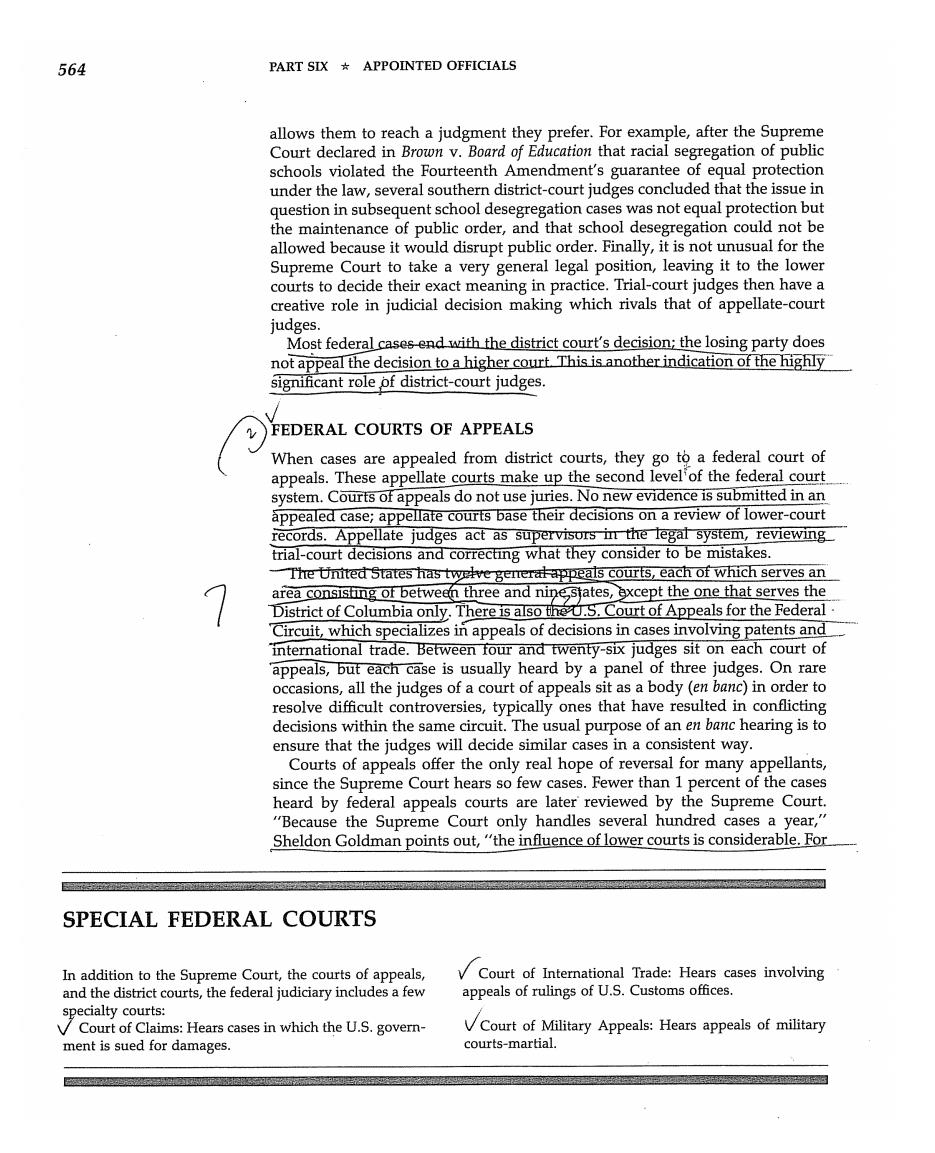
564 PART SIX APPOINTED OFFICIALS allows them to reach a judgment they prefer.For example,after the Supreme Court declared in Brown v.Board of Education that racial segregation of public schools violated the Fourteenth Amendment's guarantee of equal protection under the law,several southern district-court judges concluded that the issue in question in subsequent school desegregation cases was not equal protection but the maintenance of public order,and that school desegregation could not be allowed because it would disrupt public order.Finally,it is not unusual for the Supreme Court to take a very general legal position,leaving it to the lower courts to decide their exact meaning in practice.Trial-court judges then have a creative role in judicial decision making which rivals that of appellate-court judges. Most federal cases end with the district court's decision;the losing party does not appeal the decision to a higher court.This is another indication of the highly significant role of district-court judges. FEDERAL COURTS OF APPEALS When cases are appealed from district courts,they go to a federal court of appeals.These appellate courts make up the second levelof the federal court system.Courts of appeals do not use juries.No new evidence is submitted in an appealed case;appellate courts base their decisions on a review of lower-court records.Appellate judges act as supervisors in the legal system,reviewing trial-court decisions and correcting what they consider to be mistakes. The United States has twelve general appeals courts,each of which serves an area consisting of between three and nine states,except the one that serves the District of Columbia only.There is also the U.S.Court of Appeals for the Federal. Circuit,which specializes in appeals of decisions in cases involving patents and international trade.Between four and twenty-six judges sit on each court of appeals,but each case is usually heard by a panel of three judges.On rare occasions,all the judges of a court of appeals sit as a body(en banc)in order to resolve difficult controversies,typically ones that have resulted in conflicting decisions within the same circuit.The usual purpose of an en banc hearing is to ensure that the judges will decide similar cases in a consistent way. Courts of appeals offer the only real hope of reversal for many appellants, since the Supreme Court hears so few cases.Fewer than 1 percent of the cases heard by federal appeals courts are later reviewed by the Supreme Court. Because the Supreme Court only handles several hundred cases a year," Sheldon Goldman points out,"the influence of lower courts is considerable.For SPECIAL FEDERAL COURTS In addition to the Supreme Court,the courts of appeals, V Court of International Trade:Hears cases involving and the district courts,the federal judiciary includes a few appeals of rulings of U.S.Customs offices. specialty courts: V Court of Claims:Hears cases in which the U.S.govern- VCourt of Military Appeals:Hears appeals of military ment is sued for damages. courts-martial
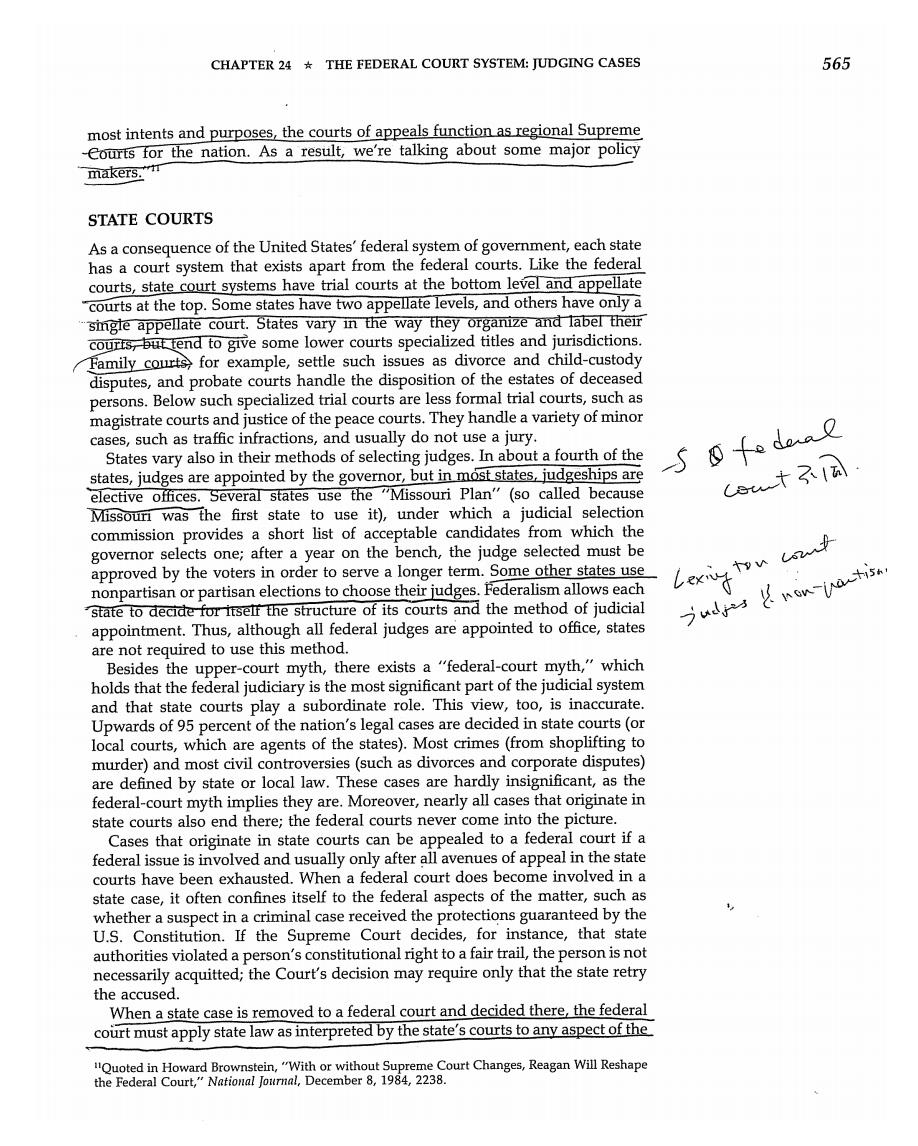
CHAPTER 24 THE FEDERAL COURT SYSTEM:JUDGING CASES 565 most intents and purposes,the courts of appeals function as regional Supreme -Courts for the nation.As a result,we're talking about some major policy makers. STATE COURTS As a consequence of the United States'federal system of government,each state has a court system that exists apart from the federal courts.Like the federal courts,state court systems have trial courts at the bottom level and appellate courts at the top.Some states have two appellate levels,and others have only a single appellate court.States vary in the way they organize and label their courts,but tend to give some lower courts specialized titles and jurisdictions. Family courts,for example,settle such issues as divorce and child-custody disputes,and probate courts handle the disposition of the estates of deceased persons.Below such specialized trial courts are less formal trial courts,such as magistrate courts and justice of the peace courts.They handle a variety of minor cases,such as traffic infractions,and usually do not use a jury. States vary also in their methods of selecting judges.In about a fourth of the euQ states,judges are appointed by the governor,but in most states,judgeships are elective offices.Several states use the "Missouri Plan"(so called because (e十子a Missouri was the first state to use it),under which a judicial selection commission provides a short list of acceptable candidates from which the governor selects one;after a year on the bench,the judge selected must be approved by the voters in order to serve a longer term.Some other states use lexiiton lot nonpartisan or partisan elections to choose their judges.Federalism allows each state to decide for itself the structure of its courts and the method of judicial ブd&non-ati appointment.Thus,although all federal judges are appointed to office,states are not required to use this method. Besides the upper-court myth,there exists a"federal-court myth,"which holds that the federal judiciary is the most significant part of the judicial system and that state courts play a subordinate role.This view,too,is inaccurate Upwards of 95 percent of the nation's legal cases are decided in state courts(or local courts,which are agents of the states).Most crimes(from shoplifting to murder)and most civil controversies(such as divorces and corporate disputes) are defined by state or local law.These cases are hardly insignificant,as the federal-court myth implies they are.Moreover,nearly all cases that originate in state courts also end there;the federal courts never come into the picture. Cases that originate in state courts can be appealed to a federal court if a federal issue is involved and usually only after all avenues of appeal in the state courts have been exhausted.When a federal court does become involved in a state case,it often confines itself to the federal aspects of the matter,such as whether a suspect in a criminal case received the protections guaranteed by the U.S.Constitution.If the Supreme Court decides,for instance,that state authorities violated a person's constitutional right to a fair trail,the person is not necessarily acquitted;the Court's decision may require only that the state retry the accused. When a state case is removed to a federal court and decided there,the federal court must apply state law as interpreted by the state's courts to any aspect of the Quoted in Howard Brownstein,"With or without Supreme Court Changes,Reagan Will Reshape the Federal Court,"National Journal,December 8,1984,2238
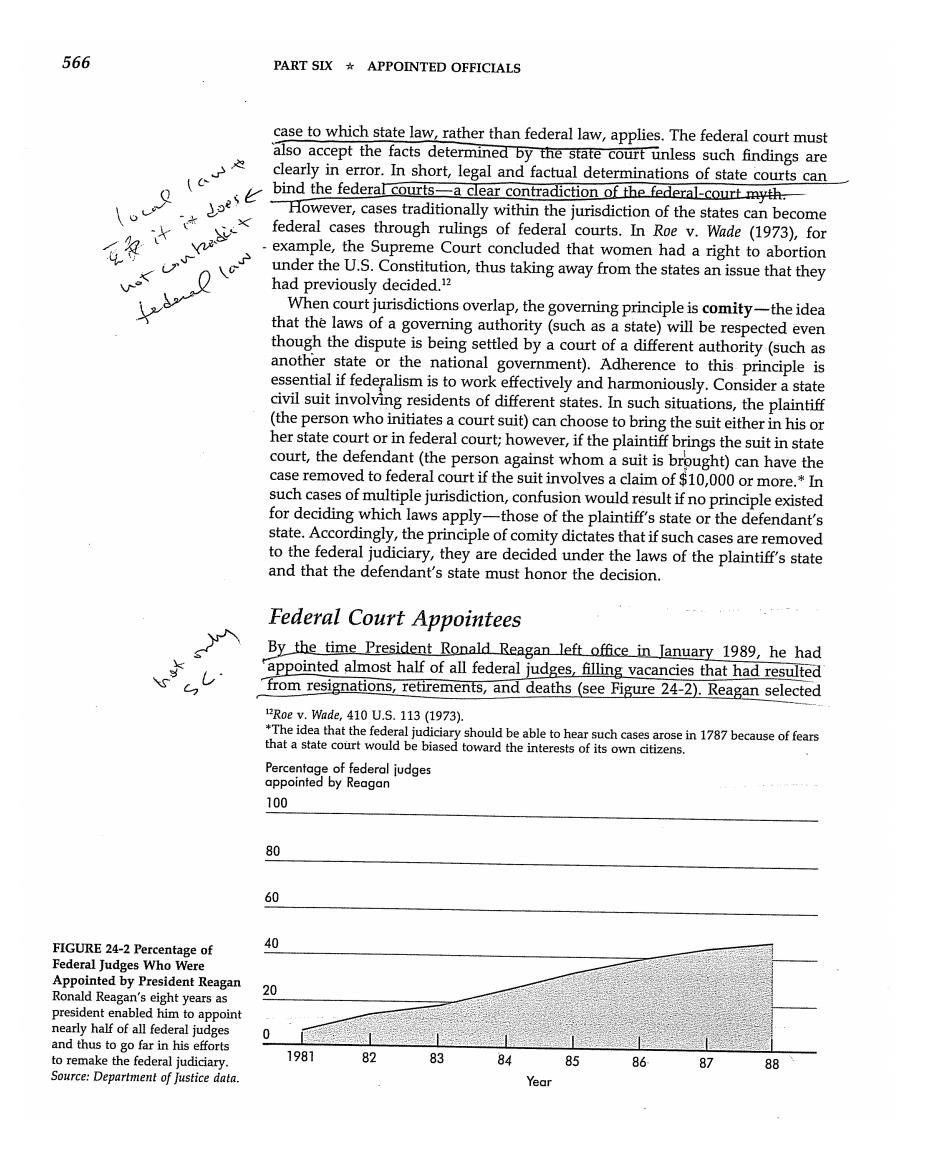
566 PART SIX APPOINTED OFFICIALS case to which state law,rather than federal law,applies.The federal court must also accept the facts determined by the state court unless such findings are clearly in error.In short,legal and factual determinations of state courts can 在录汁洪oe5← 1o0 (中 bind the federal courts-a clear contradiction of the federal-court myth. However,cases traditionally within the jurisdiction of the states can become hot cuhaditt federal cases through rulings of federal courts.In Roe v.Wade (1973),for example,the Supreme Court concluded that women had a right to abortion fdolaw under the U.S.Constitution,thus taking away from the states an issue that they had previously decided.12 When court jurisdictions overlap,the governing principle is comity-the idea that the laws of a governing authority(such as a state)will be respected even though the dispute is being settled by a court of a different authority(such as another state or the national government).Adherence to this principle is essential if federalism is to work effectively and harmoniously.Consider a state civil suit involving residents of different states.In such situations,the plaintiff (the person who initiates a court suit)can choose to bring the suit either in his or her state court or in federal court;however,if the plaintiff brings the suit in state court,the defendant(the person against whom a suit is brought)can have the case removed to federal court if the suit involves a claim of $10,000 or more.In such cases of multiple jurisdiction,confusion would result if no principle existed for deciding which laws apply-those of the plaintiff's state or the defendant's state.Accordingly,the principle of comity dictates that if such cases are removed to the federal judiciary,they are decided under the laws of the plaintiff's state and that the defendant's state must honor the decision. Federal Court Appointees By the time President Ronald Reagan left office in January 1989,he had S. appointed almost half of all federal judges,filling vacancies that had resulted from resignations,retirements,and deaths(see Figure 24-2).Reagan selected Roev.Wade,410U.s.113(1973). The idea that the federal judiciary should be able to hear such cases arose in 1787 because of fears that a state court would be biased toward the interests of its own citizens. Percentage of federal judges appointed by Reagan 100 80 60 FIGURE 24-2 Percentage of 40 Federal Judges Who Were Appointed by President Reagan Ronald Reagan's eight years as 20 president enabled him to appoint nearly half of all federal judges and thus to go far in his efforts to remake the federal judiciary. 1981 82 83 84 85 86 87 88 Source:Department of justice data Year
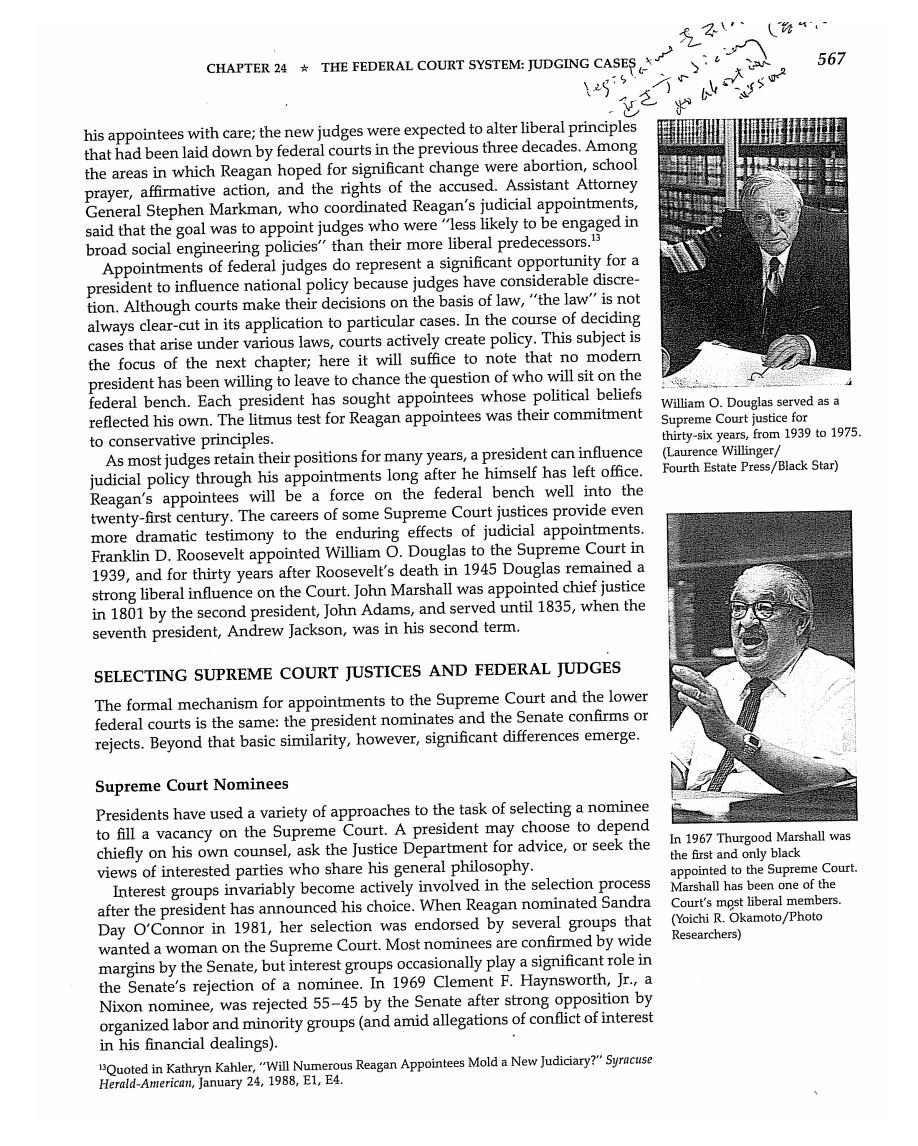
(%4,- CHAPTER24★THE FEDERAL COURT SYSTEM:JUDGING CASES+乏不({' 567 asswe his appointees with care;the new judges were expected to alter liberal principles that had been laid down by federal courts in the previous three decades.Among the areas in which Reagan hoped for significant change were abortion,school prayer,affirmative action,and the rights of the accused.Assistant Attorney General Stephen Markman,who coordinated Reagan's judicial appointments, said that the goal was to appoint judges who were"less likely to be engaged in broad social engineering policies"than their more liberal predecessors.13 Appointments of federal judges do represent a significant opportunity for a president to influence national policy because judges have considerable discre- tion.Although courts make their decisions on the basis of law,"the law"is not always clear-cut in its application to particular cases.In the course of deciding cases that arise under various laws,courts actively create policy.This subject is the focus of the next chapter;here it will suffice to note that no modern president has been willing to leave to chance the question of who will sit on the federal bench.Each president has sought appointees whose political beliefs William O.Douglas served as a reflected his own.The litmus test for Reagan appointees was their commitment Supreme Court justice for to conservative principles. thirty-six years,from 1939 to 1975. As most judges retain their positions for many years,a president can influence (Laurence Willinger/ judicial policy through his appointments long after he himself has left office. Fourth Estate Press/Black Star) Reagan's appointees will be a force on the federal bench well into the twenty-first century.The careers of some Supreme Court justices provide even more dramatic testimony to the enduring effects of judicial appointments Franklin D.Roosevelt appointed William O.Douglas to the Supreme Court in 1939,and for thirty years after Roosevelt's death in 1945 Douglas remained a strong liberal influence on the Court.John Marshall was appointed chief justice in 1801 by the second president,John Adams,and served until 1835,when the seventh president,Andrew Jackson,was in his second term. SELECTING SUPREME COURT JUSTICES AND FEDERAL JUDGES The formal mechanism for appointments to the Supreme Court and the lower federal courts is the same:the president nominates and the Senate confirms or rejects.Beyond that basic similarity,however,significant differences emerge. Supreme Court Nominees Presidents have used a variety of approaches to the task of selecting a nominee to fill a vacancy on the Supreme Court.A president may choose to depend chiefly on his own counsel,ask the Justice Department for advice,or seek the In 1967 Thurgood Marshall was the first and only black views of interested parties who share his general philosophy. appointed to the Supreme Court. Interest groups invariably become actively involved in the selection process Marshall has been one of the after the president has announced his choice.When Reagan nominated Sandra Court's mpst liberal members. Day O'Connor in 1981,her selection was endorsed by several groups that (Yoichi R.Okamoto/Photo wanted a woman on the Supreme Court.Most nominees are confirmed by wide Researchers) margins by the Senate,but interest groups occasionally play a significant role in the Senate's rejection of a nominee.In 1969 Clement F.Haynsworth,Jr.,a Nixon nominee,was rejected 55-45 by the Senate after strong opposition by organized labor and minority groups(and amid allegations of conflict of interest in his financial dealings). Quoted in Kathryn Kahler,"Will Numerous Reagan Appointees Mold a New Judiciary?"Syracuse Herald-American,January 24,1988,E1,E4
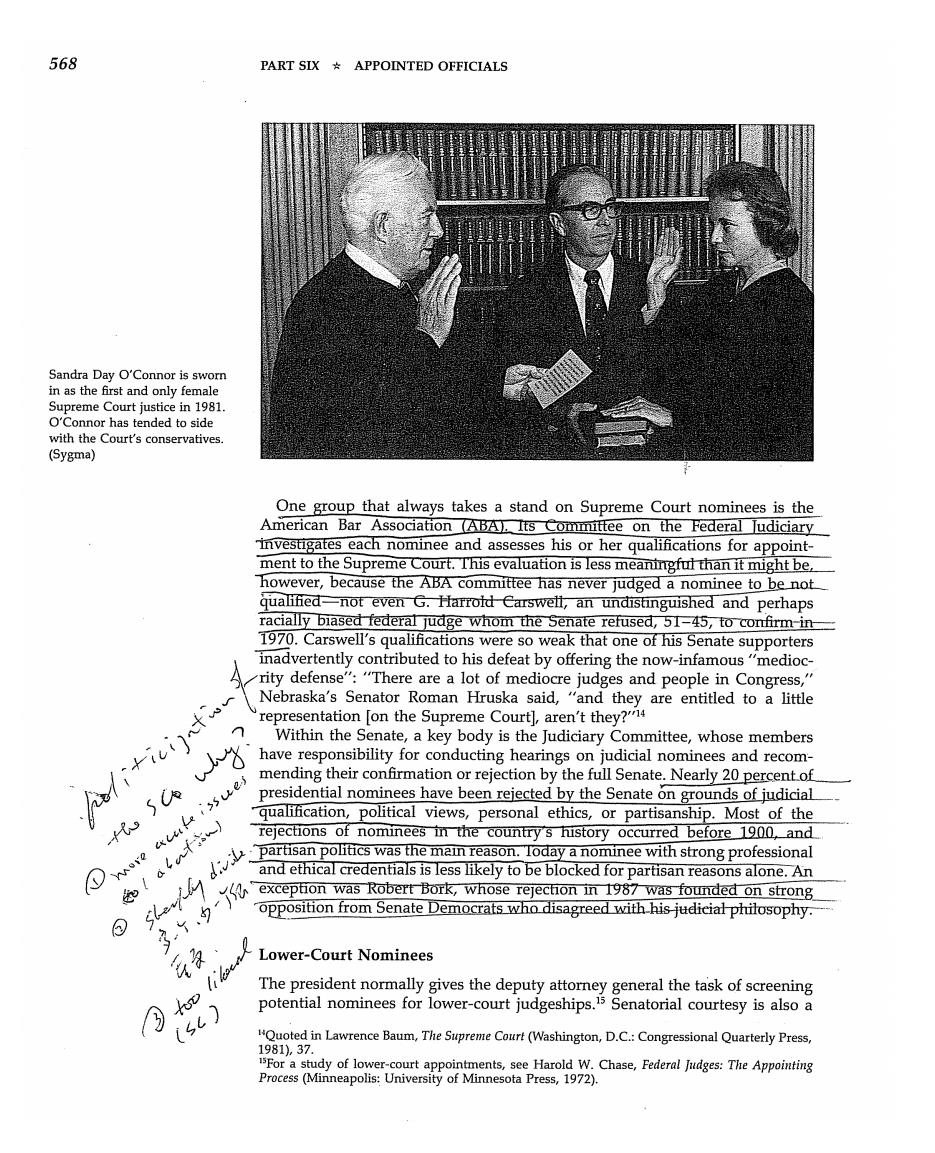
568 PART SIX APPOINTED OFFICIALS Sandra Day O'Connor is sworn in as the first and only female Supreme Court justice in 1981. O'Connor has tended to side with the Court's conservatives (Sygma) One group that always takes a stand on Supreme Court nominees is the American Bar Association (ABA).Its Committee on the Federal Judiciary investigates each nominee and assesses his or her qualifications for appoint- ment to the Supreme Court.This evaluation is less meaningful than it might be, however,because the ABA committee has never judged a nominee to be not qualified-not even G.Harrold Carswell,an undistinguished and perhaps racially biased federal judge whom the Senate refused,51-45,to confirm in 1970.Carswell's qualifications were so weak that one of his Senate supporters inadvertently contributed to his defeat by offering the now-infamous"medioc- rity defense":"There are a lot of mediocre judges and people in Congress," Nebraska's Senator Roman Hruska said,"and they are entitled to a little representation [on the Supreme Court],aren't they?" Within the Senate,a key body is the Judiciary Committee,whose members have responsibility for conducting hearings on judicial nominees and recom- mending their confirmation or rejection by the full Senate.Nearly 20 percent of wore aukissues t,sce presidential nominees have been rejected by the Senate on grounds of judicial qualification,political views,personal ethics,or partisanship.Most of the 1a1f) rejections of nominees in the country's history occurred before 1900,and ethe main reason.Today a nominee and ethical credentials is less likely to be blocked for partisan reasons alone.An exception was Robert Bork,whose rejection in 1987 was founded on strong opposition from Senate Democrats who disagreed with his judicial philosophy. ⑦ Lower-Court Nominees The president normally gives the deputy attorney general the task of screening (L) potential nominees for lower-court judgeships.Senatorial courtesy is also a Quoted in Lawrence Baum,The Supreme Court(Washington,D.C.:Congressional Quarterly Press, 1981).37. For a study of lower-court appointments,see Harold W.Chase,Federal Judges:The Appointing Process(Minneapolis:University of Minnesota Press,1972)